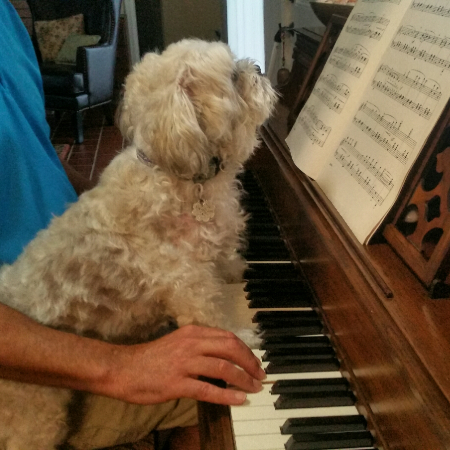How Dogs Perceive Music: Exploring Canine Preferences
Ever notice how your dog cocks his head or wags his tail when a certain tune plays? And you’re thinking, ‘He must be jamming to the song, just like me.’ Does he have any favorite genres of music, or does he think we’re weird, dancing around the house? The relationship between dogs and music is pretty fascinating, and researchers have tried to get to the bottom of it for years to see what gets those tails wagging or not.
Dogs and Their Special Sense of Hearing
Before talking about the musical tastes of our canine companions, let’s discuss how dogs hear. Dogs are different from humans because they have a very special sense of hearing. Dogs can pick up frequencies from 40 Hz to 60,000 Hz while humans can pick up only 20 Hz to 20,000 Hz. That means they hear lower and higher pitches that are quite beyond our range.

Dogs also have around 18 muscles in their ears (compared to our measly six), which allow them to move their ears independently to locate sounds with precision. So when you’re blasting Taylor Swift or Beethoven, your pup’s experience of the music is likely very different from yours. Those high-pitched notes in pop songs might stand out more to them, while deep bass might not resonate as much.
What Science Says About Dogs and Music
Research has shown that dogs don’t just passively hear music; they can respond to it emotionally, just like humans. Studies have explored the impact of different genres on dogs, and the findings are both surprising and entertaining.
Classical Music for the Win
Indeed, one study published in the journal Physiology & Behavior found that dogs were relaxed when listening to classical music. Shelter dogs, for instance, tend to bark much less, sleep more, and are altogether more relaxed when Beethoven or Mozart is played. It’s like a spa day for their ears! The soothing melodies appear to help lower their stress levels, something quite useful in environments such as animal shelters where dogs can feel anxious.
Heavy Metal is equal to High Energy
On the other hand, heavy metal music has the opposite effect. The same study observed that when dogs are exposed to loud, fast-paced metal music, they are more agitated, even barking more. Think of it as the canine equivalent of having too much caffeine-they can’t handle that much energy!
Reggae and Soft Rock: The Surprising Favorites
The fun twist? A 2017 study by the Scottish SPCA and the University of Glasgow learned that dogs were really into reggae and soft rock. Yep-you heard that right: Bob Marley just might be your dog’s jam! Scientists observed that when such genres of music were playing, dogs became much more relaxed, heart rates lowered, and they even stayed lying down much longer. Who would’ve known your furry pup secretly likes beach vibes and is laid back?
Why Do Dogs Like Some Types of Music and Not Others?
So, why do some kinds of music appeal to dogs, while others don’t? It all has to do with rhythm, pitch, and tempo.
Tempo: Dogs prefer slower tempos because they can be similar in rhythm to a calm heartbeat. This could explain why classical and soft rock are more soothing to them.

Pitch: Dogs are often over-excited or overwhelmed when it comes to high-pitched sounds, whereas low and steady tones are considered more soothing.
Repetition: Dogs are often amused by musical compositions containing repeated patterns as their brains find it much easier to follow such patterns. Sudden changes in rhythm or volume may make them nervous.
Can Dogs Recognize Human Emotions in Music?
One of the coolest aspects of dogs is their ability to sense our emotions. If you’re crying during a sad song, chances are your dog will come over to comfort you. But do they actually understand the emotion in the music itself?
A 2017 study out of the University of Vienna suggests that dogs can differentiate between happy and sad music. Researchers played tracks with different emotional tones and found that dogs reacted differently to each. Happy music often made dogs more playful, while sad music caused them to relax or cuddle up. This would show that dogs may not just hear music; they feel it.
How to Create a Playlist for Your Pup
Now that we know that dogs have musical tastes, why not make a playlist for your canine? Here are a few ways to get you started.
Go for Classical: Add some light piano or violin to get the mood going.
Add Reggae or Soft Rock: Throw in a few Bob Marley or Fleetwood Mac tracks to keep things chill.
Avoid Loud or Abrasive Genres: Avoid loud jarring genres like heavy metal, techno, or anything that involves a sudden jarring sound.
Experiment: Not all dogs are created equal. Play a few genres and gauge your dog’s reaction. Do they wag their tail and settle in or get up and leave the room? Their body language will tell you what they like.
Volume Matters: Their ears are ultrasensitive; please keep the music moderate in volume. What sounds normal to you could be overwhelming to them.
Fun Things to Do with Your Musical Dog
Why stop at merely playing music? Here are a few things one can do with their dog on an entertaining music-filled afternoon:
Dance Party: If your dog is the playful type, put on some upbeat tunes and dance around the living room together. They might even try to mimic your moves!
Relaxation Time: Use classical or reggae music during nap time to help your dog wind down after a long day of play.
Car Rides: Put together dog-friendly playlists for car rides. Music would also keep your pup calm, making the ride a pleasant experience for both.
Training Sessions: During training, it should be calming to avoid stressing the pup, just like setting up the mood for learning.
The Future of Canine Music
Believe it or not, there is music tailor-made for dogs. Companies like “Through a Dog’s Ear” develop tracks with regard for dogs’ hearing capabilities and the way they relate to the sounds on an emotional level.

Most of the compositions have uncomplicated melodies with tranquil rhythms that have a scientifically established effect of soothing dogs. One day, probably, Spotify will come up with a playlist for each breed.
Conclusion
Dogs may not understand the meaning of music in precisely the same way humans do, but they surely have their tastes and emotional responses to it. From calm symphonies to lively reggae rhythms to classic soft rock, you will connect with your dog on his frequency through this music. Next time you hit that play button, do observe the reactions of your dear canine. You might just find that your pup has better taste in music than you thought!
Tags









